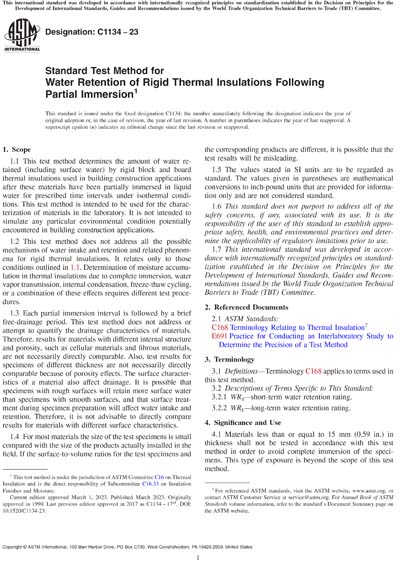Most recent
ASTM C1134-23
Standard Test Method for Water Retention of Rigid Thermal Insulations Following Partial Immersion
1.1This test method determines the amount of water retained (including surface water) by rigid block and board thermal insulations used in building construction applications after these materials have been partially immersed in liquid water for prescribed time intervals under isothermal conditions. This test method is intended to be used for the characterization of materials in the laboratory. It is not intended to simulate any particular environmental condition potentially encountered in building construction applications.
1.2This test method does not address all the possible mechanisms of water intake and retention and related phenomena for rigid thermal insulations. It relates only to those conditions outlined in 1.1. Determination of moisture accumulation in thermal insulations due to complete immersion, water vapor transmission, internal condensation, freeze-thaw cycling, or a combination of these effects requires different test procedures.
1.3Each partial immersion interval is followed by a brief free-drainage period. This test method does not address or attempt to quantify the drainage characteristics of materials. Therefore, results for materials with different internal structure and porosity, such as cellular materials and fibrous materials, are not necessarily directly comparable. Also, test results for specimens of different thickness are not necessarily directly comparable because of porosity effects. The surface characteristics of a material also affect drainage. It is possible that specimens with rough surfaces will retain more surface water than specimens with smooth surfaces, and that surface treatment during specimen preparation will affect water intake and retention. Therefore, it is not advisable to directly compare results for materials with different surface characteristics.
1.4For most materials the size of the test specimens is small compared with the size of the products actually installed in the field. If the surface-to-volume ratios for the test specimens and the corresponding products are different, it is possible that the test results will be misleading.
1.5The values stated in SI units are to be regarded as standard. The values given in parentheses are mathematical conversions to inch-pound units that are provided for information only and are not considered standard.
1.6This standard does not purport to address all of the safety concerns, if any, associated with its use. It is the responsibility of the user of this standard to establish appropriate safety, health, and environmental practices and determine the applicability of regulatory limitations prior to use.
1.7This international standard was developed in accordance with internationally recognized principles on standardization established in the Decision on Principles for the Development of International Standards, Guides and Recommendations issued by the World Trade Organization Technical Barriers to Trade (TBT) Committee.
Content Provider
ASTM International [astm]






